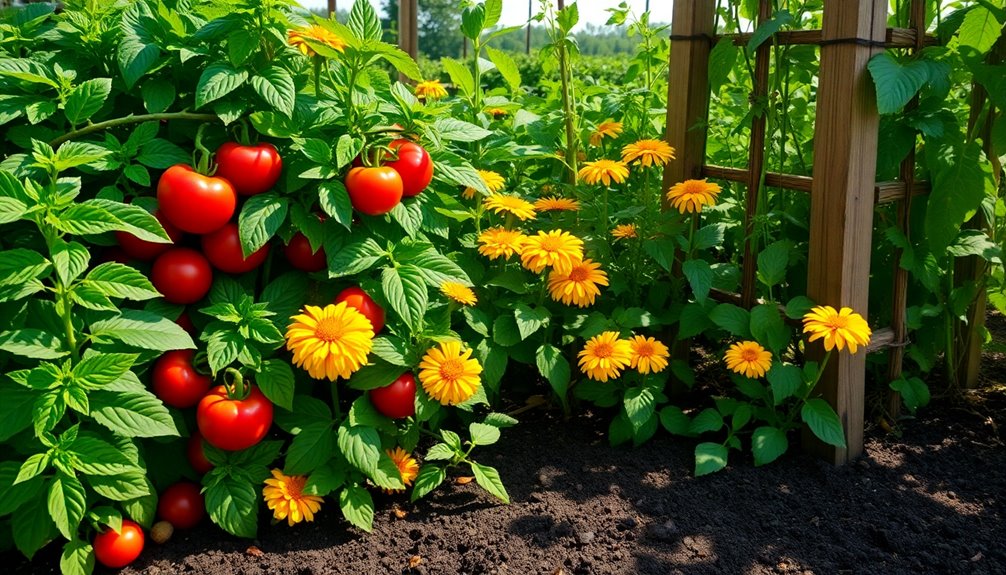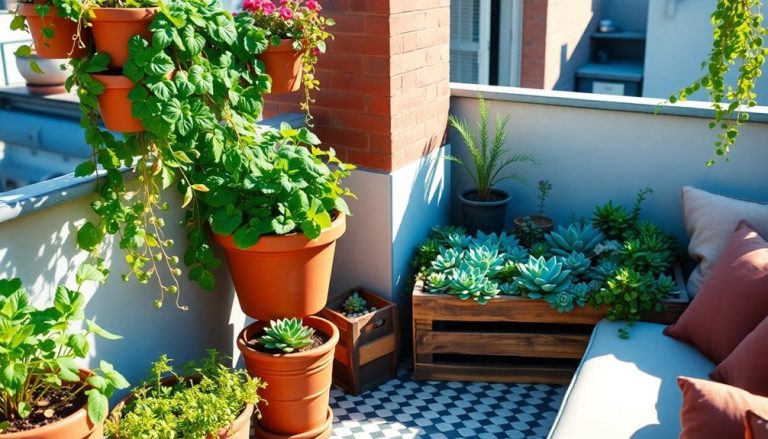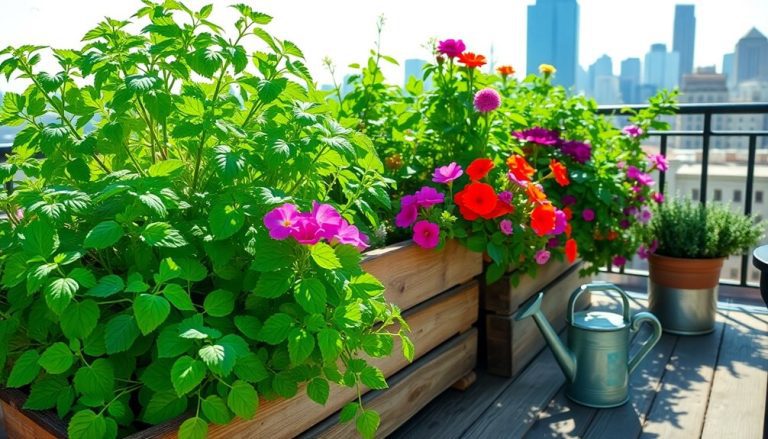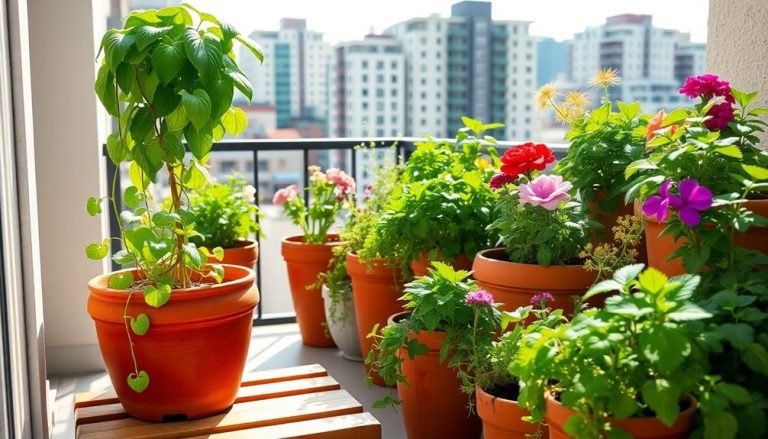To maximize your garden's potential, start by choosing complementary plants. Pair tomatoes with basil to enhance flavor and deter pests, while carrots thrive alongside onions, which repel carrot flies. Next, utilize natural pest deterrents like marigolds and garlic to protect your crops. Finally, consider space by planting taller crops with shorter ones or using trellises for climbing plants. This will optimize your garden area and boost growth. Implementing these tips will transform your garden into a flourishing ecosystem. There's plenty more to explore about companion planting techniques and their benefits.
Key Takeaways
- Pair tomatoes with basil to enhance flavor and deter pests, creating a thriving garden environment.
- Use nitrogen-fixing beans alongside corn to enrich soil and support growth, maximizing productivity.
- Group plants with similar sunlight and space needs to prevent overcrowding and ensure optimal growth.
- Incorporate natural pest deterrents like marigolds and garlic to reduce reliance on chemical pesticides.
- Rotate crops annually to maintain soil health and prevent disease buildup in your garden.
Choose Complementary Plants
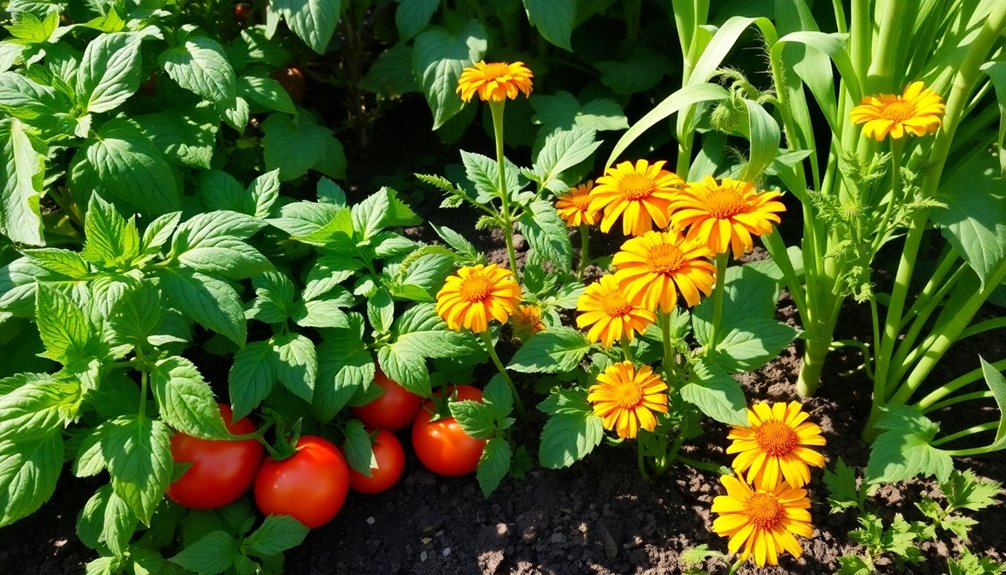
When planning your garden, you often want to choose complementary plants that work well together. These pairings can enhance growth, improve flavor, and deter pests naturally. For instance, consider planting tomatoes alongside basil. This combination not only boosts the flavor of your tomatoes but also helps keep pests at bay.
Another excellent pairing is carrots and onions. These two plants can coexist harmoniously, as the onion's strong scent can repel carrot flies, protecting your crop.
Additionally, beans and corn make a classic duo. Beans fix nitrogen in the soil, enriching it for the corn, while the corn provides support for the climbing beans.
Be mindful of the space requirements and sunlight preferences of each plant. Group plants with similar needs to ensure they thrive.
Avoid planting incompatible species, like cabbage and strawberries, which can stunt each other's growth.
Utilize Natural Pest Deterrents
Choosing complementary plants not only boosts growth but can also play a significant role in naturally deterring pests. By strategically selecting plants that repel unwanted insects, you'll create a healthier garden environment.
For example, marigolds are known for their ability to deter nematodes and aphids. Planting them alongside your vegetables can protect your crops from these pests.
Basil is another excellent choice, as its strong scent keeps flies and mosquitoes at bay. Placing basil near tomatoes not only enhances their flavor but also helps ward off pests.
Additionally, garlic, with its pungent aroma, can repel a variety of insects. You might consider planting it among your other crops for added protection.
Don't forget about herbs like mint and rosemary, which can also act as natural deterrents. Just be cautious with mint, as it's quite invasive; you might want to plant it in containers.
Lastly, consider utilizing flowers like nasturtiums, which attract aphids away from your main crops. By incorporating these natural pest deterrents into your garden, you'll create a more resilient ecosystem, allowing your plants to thrive while minimizing the need for chemical pesticides.
Maximize Space and Resources
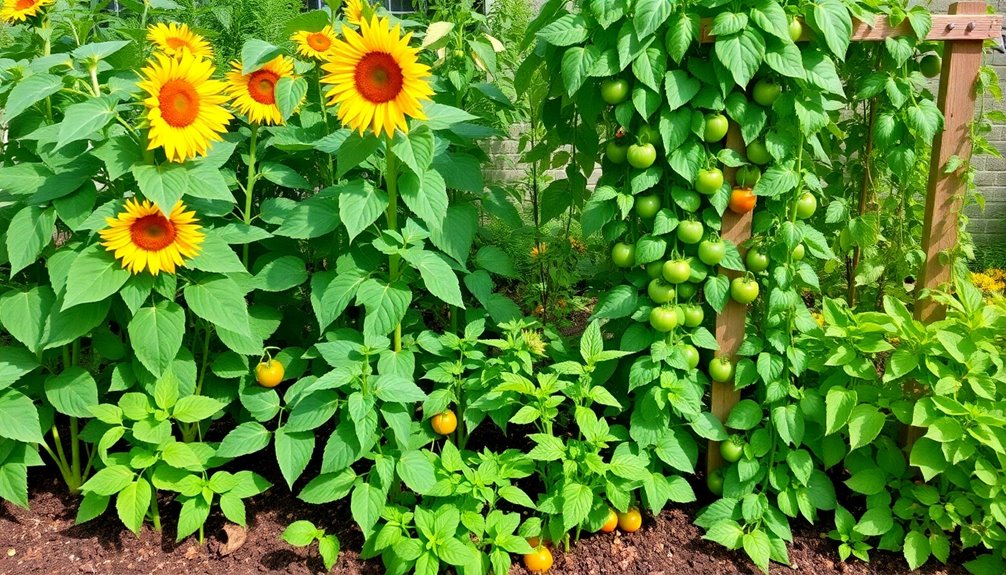
Maximizing space and resources in your garden can transform it into a flourishing oasis. By practicing companion planting, you not only enhance the growth of your plants but also make the most of your available garden area. Consider planting taller crops alongside shorter ones, allowing you to utilize vertical space effectively.
Here's a quick overview of some ideal companion pairs to help you maximize your garden:
| Plant Type | Companion Plant |
|---|---|
| Tomatoes | Basil |
| Carrots | Onions |
| Corn | Beans |
| Cabbage | Dill |
| Radishes | Spinach |
Incorporating these combinations can lead to improved yields and healthier plants. Additionally, try using vertical gardening techniques, like trellises or cages, to allow climbing plants to share space with lower-growing crops. This way, you're not just saving space but also enhancing air circulation and light exposure. Remember, the key is to create a balanced ecosystem where plants can thrive together, making your garden a vibrant, productive space.
Frequently Asked Questions
Can Companion Planting Improve Soil Health and Fertility?
Companion planting can definitely improve soil health and fertility. You're creating a diverse ecosystem, enhancing nutrient cycling, and promoting beneficial microorganisms. Plus, certain plants can fix nitrogen, enriching the soil for future growth.
How Do I Know Which Plants Are Compatible?
Did you know that nearly 70% of gardeners believe in the benefits of plant compatibility? To find compatible plants, research their growth habits, nutrient needs, and pest resistance, or consult local gardening resources for guidance.
Are There Any Plants I Should Avoid Together?
Yes, certain plants don't thrive together. For instance, avoid planting tomatoes with potatoes, as they can share pests. Likewise, onions and beans clash, inhibiting each other's growth. Always research compatibility before planting to ensure success!
Can Companion Plants Enhance the Flavor of Vegetables?
Yes, companion plants can enhance the flavor of your vegetables. By planting herbs like basil or cilantro nearby, you can boost taste and aroma, creating a more delicious harvest that's sure to impress your taste buds.
How Often Should I Rotate Companion Plants in My Garden?
You might think rotating companion plants isn't necessary, but it's crucial! Aim to rotate them every season. This practice prevents nutrient depletion and pests, ensuring a healthier, more productive garden for you to enjoy.
Conclusion
In the garden of life, your choices shape the harvest. By choosing complementary plants, you're like a skilled conductor, harmonizing nature's symphony. Embracing natural pest deterrents turns your garden into a fortress, safeguarding your dreams. And maximizing space and resources transforms your plot into a thriving community, where every plant plays its part. So, as you cultivate your garden, remember: it's not just about the flowers you grow, but the connections you nurture along the way.

